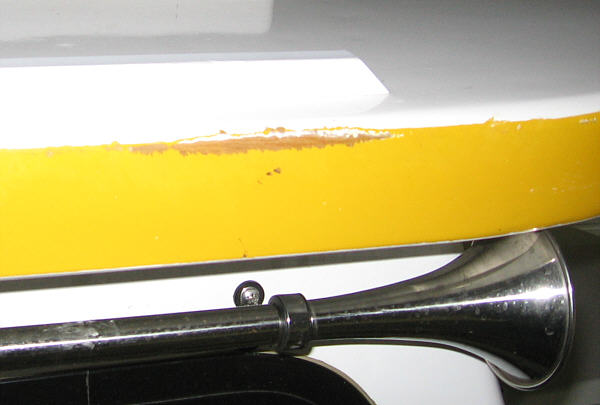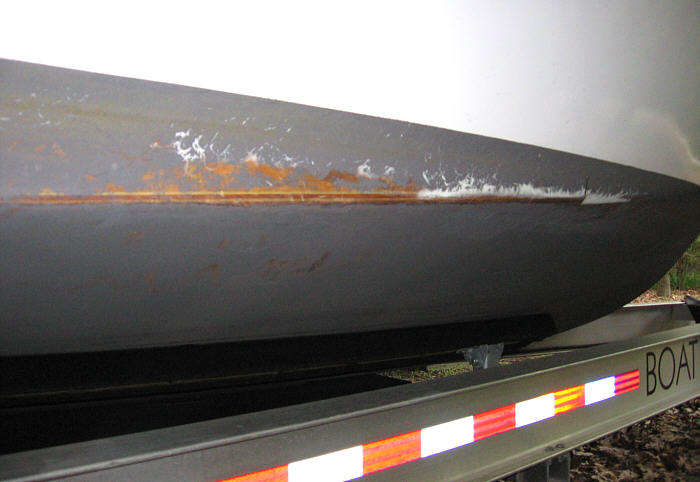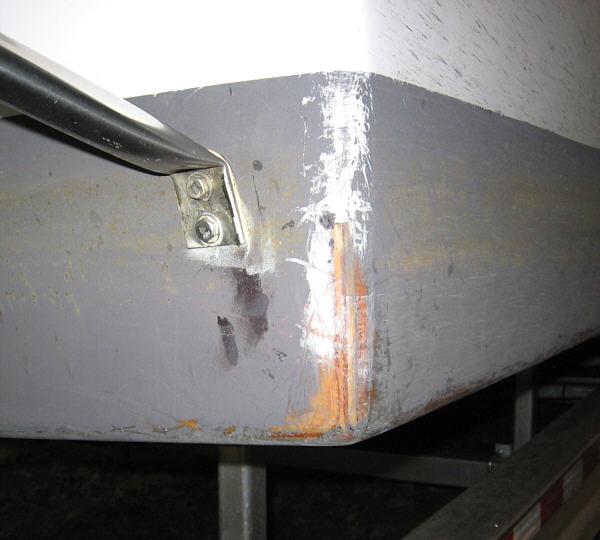|
It had been a
delightful long weekend on Kentucky Lake. We had towed SeaQuinn the 150
miles Thursday night, dropped in and then spent the next three days
cruising the Lake with no particular agenda other than to
relax. But now Sunday evening was
approaching and we would be anchoring out for our final night and then
returning Monday morning. The evening forecast had
called for southerly winds 10 to 15 mph. With that in mind I choose a
cove, which offered protection from the open lake channel as well as the
predicted southward breeze.
We were fairly exposed to the west but because of the forecast it
wasn't a big concern. As the sun receded the wind had dropped to not much
more than a gentle sigh. As usual, the boat's shallow
draft allowed me to slip in close and crowd the shoreline. The hook was dropped in 8
feet of water and I had allowed the windlass to pay out enough rode to
hold us off the bank if the wind decided to enforce its will. We settled in for a little reading
and movie on DVD. About 11:30
we withdrew to the berth and allowed the utter quiet to hasten our
sleep.
About 1:30 I was awaken by distant thunder. As I lie there partly awake listening for other hints of changing weather, I realized the wind had increased although it was still fairly mild. Glancing out the berth's portlight I could tell it was out of the West not the South. Then suddenly it howled. The vibrating VHF antenna produced a low frequency hum I had never heard before and trees ashore whined as the wind crashed into them.
I jumped from the bunk and
stepped up into the saloon hoping to see we were hanging firmly on the
anchor and facing the storm.
We were not. Through
the darkness the anchor light was providing just enough illumination I
could see we were sideways to the wind and drifting quickly towards the
bank. I could make out
silhouetted trees and brush growing ever larger as we closed the narrow
gap between land and sea.
There was no time to react, no time to correct - we were going
ashore. My only preventive
action was to trim the outboard up to prevent it from digging in as we
made contact. The starboard side landing was
gentler than I expected. A
tree about 12" in diameter kissed the rubrail about a foot forward of the
transom and brush along the water line seemed to cushion the remaining
hull. I slid open the helm
door and looked out into the night.
As the wind blew the rain over the cabin the trees were flailing
about as their leaves tore free and were cast into the dark abyss. I then noticed that the tree
holding us off the shore was beginning to move up the hull as the storm
was slowly dragging us aft. I quickly decided at this
point the tree was our friend.
Without it the wind would possibly blow the boat aground hard
enough we could not float it without assistance. I hurried aft and out into the
open cockpit to retrieve a mooring line. When I returned to the helm I
found the tree was continuing to slide towards the bow and was now
approaching the opening. With
small branches protruding into the cabin through the open door I managed
to slip the eyed end of the line over the amidship cleat and then around
the tree. I wrapped the bitter end back around the cleat but with the tree
continuing to move forward I did not have time to secure it. I needed to
stop the reward slide so with a tight grip, held the line. The aft motion
stopped. With the tree now holding
center in the helm door I could see the rubrail was protecting the hull as
it hammered against it. Not a
good scenario but the heavy-duty vinyl rail seemed to be handling the
abuse. But then the situation
deteriorated even more. The open water to our West
was now starting to build. As each wave came to shore it lifted the hull
better than a foot and caused it to roll. With each cycle the cabin roof
overhang began violently slamming into the tree. The sound was sickening.
For a second I considered letting go and allowing the wind to drag us away
from this destruction but I was now certain it would result in a serious
grounding.
I decided I could possibly
help cushion the blows if I could manage to get one of our 10" diameter
fenders between the hull and the tree. But I could not let go of the line
and the fenders were stored outside in a cockpit locker. I hesitated for a moment but
seeing no other choice I asked my wife to go out into the storm and
retrieve a fender. Without
pause she exited the saloon and quickly reentered dripping wet but with
the bright yellow fender in hand. I first tried dropping the fender between the hull and the tree but found it produced negligible results as the overhang continued to impact the tree as the hull pitched. So then as the cabin rolled away I managed to force the fender up between the two. Each contact nearly flattened it but it held and immediately stopped the solid hits. But there was no way I could secure the fender in place and with each wave I had to reposition it to accept the next strike. I needed both hands to do this so with reluctance passed the end of the mooring line to my wife not knowing if she would be able to handle the load. She did.
So now our plan of action was
formed and we would just need to persist until the blow lessened. As time passed the muscles in my
elevated arms began to burn and ache but I knew I had to hold fast. It
continued for what seemed like an hour but was actually about 20 minutes.
During that time I can remember thinking two things: First, how much
damage is the storm bestowing on my pride and joy? And second, will my wife ever
overnight on the boat again? Finally, the wind started to
subside and along with it the heavy rolling. I then found I could remove the
fender and sit in the helm seat with my feet against the tree and hold the
hull away without too much strain.
I also could handle the mooring line, which allowed my wife to sit
down and rest a little. For another 40 minutes we held this position as
the wind continued.
This gave me time to consider
our situation and ponder if and how I could move away from shore, as odds
were the wind was not going to stop completely. I powered on the bow and
transom depth sounders (I had installed a transducer forward to assist in
entering shallow oxbows and backwater). To my surprise they were both
showing about 2 1/2 feet of water - so we were indeed still
floating. I then decided to try the
windlass. It reeled in a good
section of line with no resistance but then the 22 lbs Bruce type anchor
dug in and seemed to hold. By
bumping the windlass I found I could pull the bow away from the shore. As
the wind slowed I had my wife hold the hull off the tree and I scampered
back for a quick look of the outboard. The area around it appeared to be
clear of obstructions. I returned to the helm resuming my role as a human
fender but now had a plan. The wind finally diminished
to a level I thought acceptable and I trimmed down the Honda and fired the
engine. Cutting it hard to the port I went to reverse and added a little
throttle. This started to
pull the transom away from the bank.
Hoping the anchor would hold, at the same time I started cranking
the windlass, which moved the bow away. Slowly we began a coordinated
sideslip from the shore. When
a safe distance away I added more throttle and allowed the bow to swing
downwind as I continued to back away. Now free of the hazards ashore I was
finally able to breathe a small sigh of relief.
Not wanting to try to
relocate in the dark we decided to move farther out and reset the anchor.
It took two attempts to get a solid bite but finally I was satisfied it
had a firm grip on the bottom. The rest of the night brought a mix of
relative calm and moderate winds along with a little distant thunder. It
made for an uneasy rest. But somehow morning light always seems to bring
along a feeling of security and I welcomed its arrival. We motored about 2 miles to the
harbor where our trailer sat ready to retrieve our battered but sound
craft. Once on the hard I was able to survey the damage. Considering the beating the boat had taken I was amazed how little harm had been done. Other than the rubrail being about a 1/4" out of place in one small area (easy fix) there was no structural damage. Along the roofline a narrow strip of the paint was rubbed off down to the epoxy but the fiberglass showed no damage. Similarly along the chine in several places the ablative bottom paint had also been wiped clean but again the glass and plywood beneath was unharmed. The bottom paint would be another easy fix but the roofline repair would be more involved as two colors were in play. Still I was thrilled and astounded with the lack of any serious damage. I expected much more.
Epilog I have long held the belief
that every mistake is an opportunity for education and looking back at
this event I see there are several things to be learned. I violated a number of conventions
about anchoring and only utter luck prevented more serious consequences. I
somewhat blame this on becoming complacent when using my Cabin Skiff. Being a much smaller and lighter
craft I seemed to have developed a few bad habits regarding anchoring
practices, which have been reinforced by having suffered no serious
problems. But then again, I have never ridden out a storm of this
magnitude while on the hook. Two errors were classic. I
failed to pay out enough rode meet the suggested 5 to 1 ratio much less
the more preferred 7 to 1. Also, I failed to properly set the anchor by
powering back hard and digging it in. The next error was of
location. I had checked the forecast and accounted for the predicted
southerly winds but this was done more for comfort than safety. I should have acknowledged in our
area most storms approach from the south and west, so allowing a large
open western exposure proved to be a serious mistake. At times this situation cannot be
prevented and a properly set anchor should prevail. In this case I did
have other options but instead choose to follow the path of convenience
rather than caution - obviously, a poor choice.
In retrospect, I could have
done several things to avert this near disaster and any one of them may
have prevented it entirely.
But now it shall serve as a wake-up call reminding me although the
water can provide wonderful pleasures it also has the power to create
mayhem for anyone who forgets to give it the utmost attention and respect.
And about my other concern -
my wife of 40 years was unshaken by the experience, and like me, looks
forward to our next river adventure. My wife forced me to add
this one minor omitted detail - she thinks it is funny
.............. Being a little warm in the berth that
night I had gone to bed wearing nothing but a smile. And during the entire experience
the only thing that changed was I took off the smile! She said whenever she started to
grow apprehensive she would just step back a little and look at me - stark
naked battling the tree - and had to grin at the bizarre sight!
|


